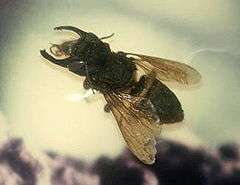Megachile pluto
| Megachile pluto | |
|---|---|
 | |
| Scientific classification | |
| Kingdom: | Animalia |
| Clade: | Euarthropoda |
| Class: | Insecta |
| Order: | Hymenoptera |
| Family: | Megachilidae |
| Genus: | Megachile |
| Subgenus: | Megachile (Callomegachile) |
| Species: | M. pluto |
| Binomial name | |
| Megachile pluto B. Smith, 1860 | |
| Synonyms | |
| |
Megachile pluto, also known as Wallace's giant bee, is a very large Indonesian resin bee. It is the largest known living bee species. It was believed to be extinct until its rediscovery in 1981.
Description
Females may reach a length of 38 mm (1.5 in), with a wingspan of 63.5 mm (2.5 in). Males only grow to about 23 mm (0.9 in) long. M. pluto is believed to be the largest living bee species.[2]
Distribution and habitat
Wallace's giant bee has only been reported from three islands of the North Moluccas in Indonesia: Bacan, Halmahera and Tidore. Very little is known about its distribution and habitat requirements, although it is thought that it is restricted to primary lowland forests.[1]
Discovery and rediscovery
The species was originally collected by Alfred Russel Wallace in 1858, and given the common name "Wallace's giant bee"; it is also known as the "giant mason bee". It was thought to be extinct until it was rediscovered in 1981 by Adam C. Messer, an American entomologist, who found six nests on the island of Bacan and other nearby islands.[2] The bee is among the 25 “most wanted lost” species that are the focus of Global Wildlife Conservation’s “Search for Lost Species” initiative.[3]
Ecology
Wallace's giant bees build communal nests inside active nests of the tree-dwelling termite Microcerotermes amboinensis, which may have served to hide their existence even from island residents. The bee uses tree resin to build compartments inside the termite nest. The association of the bee with the termite may be obligate.[2][1]
See also
- Asian giant hornet - the largest living hornet
- Tarantula hawk wasp and Megascolia procer - the largest living wasps
References
- 1 2 3 Kuhlmann, M. (2014). "Megachile pluto". IUCN Red List of Threatened Species. IUCN. 2014: e.T4410A21426160. Retrieved 8 July 2016.
- 1 2 3 Messer, A. C. (1984). "Chalicodoma pluto: The World's Largest Bee Rediscovered Living Communally in Termite Nests (Hymenoptera: Megachilidae)". Journal of the Kansas Entomological Society. 57 (1): 165–168. JSTOR 25084498.
- ↑ "The Search for Lost Species". Global Wildlife Conservation. Retrieved 2017-06-02.
